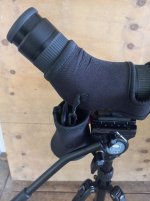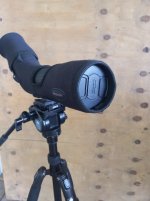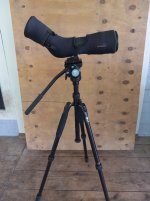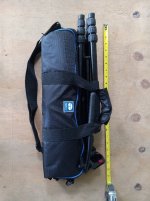Hi Bird Forum folks,
My serious birding days were over about 45 years ago. I’m nibbling on the edges again, having decided to point optics at the earth for the first time in ages after taking up astronomy 30 years ago. With this background I wanted to offer a less than fully informed opinion of the Athlon Ares G2 UHD 65mm spotter with 15-45x zoom eyepiece.
As a long time user of high end apochromatic refractors on the night sky I thought I would start at the top of the food chain and began looking at the usual suspects. I got superb advice from many BF members after posting a question on spotter selection. Aperture got smaller and smaller as the budget became increasingly realistic. I began to wonder if some of the well regarded lower cost offerings would suit my needs, especially considering that the hot birding scope of my early days was the B&L Zoom 60. I tried an Svbony SV406P which I thought had astonishingly good optics for the money but the mechanics seemed a bit vulnerable to me so it was returned. My preference in this type of application is a barrel focuser and the Athlon Ares 65mm angled spotter caught my eye. They come equipped with a 15-45x zoom producing about 3.2 degree TFOV at 15x, dropping down to about half that at 45x. I was not too worried about a cap at 45x as we rarely cranked the Zoom 60 all the way up back then due to seeing conditions and dimness of view - more on this later. While the prospect of such a wide field of view was enticing, I was concerned that such a short focal length scope would display significant false color but as it turned out I needn’t have worried.
I ordered the scope and was initially pleased with its performance. Monitoring a Pileated working at the edge of the woods near my house or the foxes and turkeys in the pasture provided wonderful views. I was surprised how often I had the scope dialed up to 45x and how easy acquiring objects was at 15x. Trips to the river revealed a wonderful array of waterfowl. A quick view of a centered star showed concentric diffraction rings on either side of focus. Edge performance is better than I anticipated. The little bit of pincushion distortion was quite tolerable and panning with the scope was easy on the eye. Most importantly, the scope is sharp. So far, so good!
The scope initially lived on a Manfrotto 3011 tripod that outweighed the scope by a considerable margin. Coming from an astronomy background, at first I thought this was fine but the merits of a lighter tripod began to make themselves clear. I went back to the vendor site and saw that this scope was offered as a package with the absurdly small and lightweight Sirui T-004S aluminum tripod. When the tripod arrived I thought it was a joke. The smallest leg extension was tiny. This turned out to be another learning opportunity though as the little spotter is well supported by this 1kg tripod. The Sirui head is well built with a very convenient shoe. Altitude adjustment is easily damped to my liking. Azimuth damping adjustment is less sensitive but adequate. Most importantly, the package is very easy to hike with!
There is an unexpected quirk of the scopes clothing that turns out to be quite convenient. The eyepiece cover forms a bucket when removed. The eyepiece cap comes off with it nearly every time and the bucket forms an easy to use receptacle for the objective cap. The objective cap is retained by spring loaded edge clips that do the job but can be dislodged unintentionally. In transit I’ve taken to retracting the glare/dew shield and pulling the neoprene jacket past the objective end. The neoprene contracts a bit and captures the lens cap more securely. Another happy wardrobe adaptation is that the tripod bag holds the scope nicely while the bag handle can secure the tripod itself. In terms of other mechanical considerations, the eyecup is continuously adjustable and moved very smoothly. The focuser and zoom are also especially smooth. Mechanics are very pleasing. I don’t know if it will stiffen up when it gets very cold here but I guess I’ll find out.
My only knock on this scope isn’t really the scope’s fault at all. Waterfowl in a small bay or on the river are easily viewed. The scope is a little out of its depth on low contrast birds at distance on the dark ocean water. If I wasn’t 100 miles inland, I might have chosen a different scope. Someday I might spring for a bright and beautiful 80mm spotter that can operate at higher than 45x but for now, this little 65mm scope is serving me just fine. My opinion is based on limited experience but I think this package performs exceptionally well for its price point. My larger fluorite telescope put up a sharper image with more saturated colors but doesn't embarrass the Athlon scope and its compactness makes it hard not to take along.
My serious birding days were over about 45 years ago. I’m nibbling on the edges again, having decided to point optics at the earth for the first time in ages after taking up astronomy 30 years ago. With this background I wanted to offer a less than fully informed opinion of the Athlon Ares G2 UHD 65mm spotter with 15-45x zoom eyepiece.
As a long time user of high end apochromatic refractors on the night sky I thought I would start at the top of the food chain and began looking at the usual suspects. I got superb advice from many BF members after posting a question on spotter selection. Aperture got smaller and smaller as the budget became increasingly realistic. I began to wonder if some of the well regarded lower cost offerings would suit my needs, especially considering that the hot birding scope of my early days was the B&L Zoom 60. I tried an Svbony SV406P which I thought had astonishingly good optics for the money but the mechanics seemed a bit vulnerable to me so it was returned. My preference in this type of application is a barrel focuser and the Athlon Ares 65mm angled spotter caught my eye. They come equipped with a 15-45x zoom producing about 3.2 degree TFOV at 15x, dropping down to about half that at 45x. I was not too worried about a cap at 45x as we rarely cranked the Zoom 60 all the way up back then due to seeing conditions and dimness of view - more on this later. While the prospect of such a wide field of view was enticing, I was concerned that such a short focal length scope would display significant false color but as it turned out I needn’t have worried.
I ordered the scope and was initially pleased with its performance. Monitoring a Pileated working at the edge of the woods near my house or the foxes and turkeys in the pasture provided wonderful views. I was surprised how often I had the scope dialed up to 45x and how easy acquiring objects was at 15x. Trips to the river revealed a wonderful array of waterfowl. A quick view of a centered star showed concentric diffraction rings on either side of focus. Edge performance is better than I anticipated. The little bit of pincushion distortion was quite tolerable and panning with the scope was easy on the eye. Most importantly, the scope is sharp. So far, so good!
The scope initially lived on a Manfrotto 3011 tripod that outweighed the scope by a considerable margin. Coming from an astronomy background, at first I thought this was fine but the merits of a lighter tripod began to make themselves clear. I went back to the vendor site and saw that this scope was offered as a package with the absurdly small and lightweight Sirui T-004S aluminum tripod. When the tripod arrived I thought it was a joke. The smallest leg extension was tiny. This turned out to be another learning opportunity though as the little spotter is well supported by this 1kg tripod. The Sirui head is well built with a very convenient shoe. Altitude adjustment is easily damped to my liking. Azimuth damping adjustment is less sensitive but adequate. Most importantly, the package is very easy to hike with!
There is an unexpected quirk of the scopes clothing that turns out to be quite convenient. The eyepiece cover forms a bucket when removed. The eyepiece cap comes off with it nearly every time and the bucket forms an easy to use receptacle for the objective cap. The objective cap is retained by spring loaded edge clips that do the job but can be dislodged unintentionally. In transit I’ve taken to retracting the glare/dew shield and pulling the neoprene jacket past the objective end. The neoprene contracts a bit and captures the lens cap more securely. Another happy wardrobe adaptation is that the tripod bag holds the scope nicely while the bag handle can secure the tripod itself. In terms of other mechanical considerations, the eyecup is continuously adjustable and moved very smoothly. The focuser and zoom are also especially smooth. Mechanics are very pleasing. I don’t know if it will stiffen up when it gets very cold here but I guess I’ll find out.
My only knock on this scope isn’t really the scope’s fault at all. Waterfowl in a small bay or on the river are easily viewed. The scope is a little out of its depth on low contrast birds at distance on the dark ocean water. If I wasn’t 100 miles inland, I might have chosen a different scope. Someday I might spring for a bright and beautiful 80mm spotter that can operate at higher than 45x but for now, this little 65mm scope is serving me just fine. My opinion is based on limited experience but I think this package performs exceptionally well for its price point. My larger fluorite telescope put up a sharper image with more saturated colors but doesn't embarrass the Athlon scope and its compactness makes it hard not to take along.
Attachments
Last edited:








